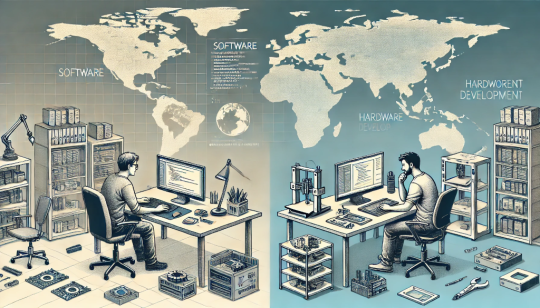
Navigating Remote Work in a Hardware Development Agency
Remote work has become a common practice across many industries, but when it comes to hardware development, it presents a unique set of challenges and benefits. At HW Lab, we have embraced this model fully. With our team spread across the globe—myself in Japan handling software development and my co-founder, Pedro, in Argentina overseeing hardware—remote work is not just an option; it’s our reality. Here’s how we navigate the complexities of remote work in a hardware development agency.
The Challenges of Remote Work in Hardware Development
Time Zone Differences: Working from opposite sides of the globe means Pedro and I are always managing a 12-hour time difference. This makes synchronous communication tricky, requiring us to carefully plan our meetings and collaborate asynchronously. To bridge this gap, we rely heavily on tools like Slack and Zoom for clear communication and regular updates.
Coordination of Physical Components: Unlike software, hardware development requires the manipulation of physical components. This presents logistical challenges, such as shipping prototypes and hardware parts between Japan and Argentina. We’ve had to become adept at planning our prototype cycles to account for these delays, ensuring we stay on schedule without unnecessary setbacks.
Maintaining a Unified Vision: When working remotely, it’s easy to have misunderstandings or diverging ideas about project goals. To avoid this, we emphasize documentation and clarity. Using tools like Trello and Notion helps us keep track of tasks and project milestones, ensuring we’re always aligned on our vision for WebScreen and other projects.
Hands-On Collaboration Limitations: Hardware development often benefits from hands-on collaboration. However, with us being remote, we’ve had to adapt by using video calls to share real-time updates, walkthroughs, and demonstrations of hardware functionality. While it’s not the same as being in the same room, it has allowed us to stay closely connected and engaged with each other’s work.
The Benefits of Remote Work in Hardware Development
Global Talent and Diverse Perspectives: Our remote setup allows us to bring diverse perspectives to the table. Working from Japan and Argentina means we’re exposed to different market needs, consumer behaviors, and cultural insights, enriching our product development process. This diversity has been particularly beneficial in designing WebScreen to appeal to a global audience.
Flexibility and Autonomy: Being remote gives us the flexibility to work during our most productive hours and the autonomy to manage our workflows. This flexibility fosters a culture of trust and independence, enabling us to focus on our strengths—Pedro on hardware and me on software—while working collaboratively on the broader vision.
Cost Efficiency: By operating remotely, we save on overhead costs associated with a traditional office setup. This allows us to allocate more resources towards R&D and innovation, which is crucial for a growing hardware development agency like ours.
Enhanced Focus and Productivity: Remote work has allowed us to create environments tailored to our personal productivity. For instance, I have set up a dedicated home office in Japan, while Pedro has optimized his workspace in Argentina for hardware testing and development. These tailored setups minimize distractions and maximize our productivity.
How We Make It Work
Regular Check-Ins and Updates: Despite the challenges, Pedro and I maintain a strict schedule of regular check-ins to ensure we’re on the same page. These meetings help us address any issues promptly and keep our momentum going.
Leveraging Technology: We use a suite of digital tools to keep us connected and on track. Tools like Slack, Zoom, and Google Workspace help us manage communication and collaboration, while project management tools like Trello and Notion keep our tasks organized.
Clear Communication and Documentation: In a remote setup, clear communication is key. We prioritize detailed documentation to capture decisions, ideas, and next steps, ensuring there’s no ambiguity about what needs to be done.
Looking Ahead
While remote work in hardware development has its challenges, the benefits far outweigh them for us at HW Lab. As we continue to develop WebScreen and other innovative products, we are committed to refining our remote work practices and leveraging the strengths that come with a global, distributed team.
Remote work allows us to stay agile, think globally, and collaborate effectively, ensuring that HW Lab remains at the forefront of hardware and software innovation.


